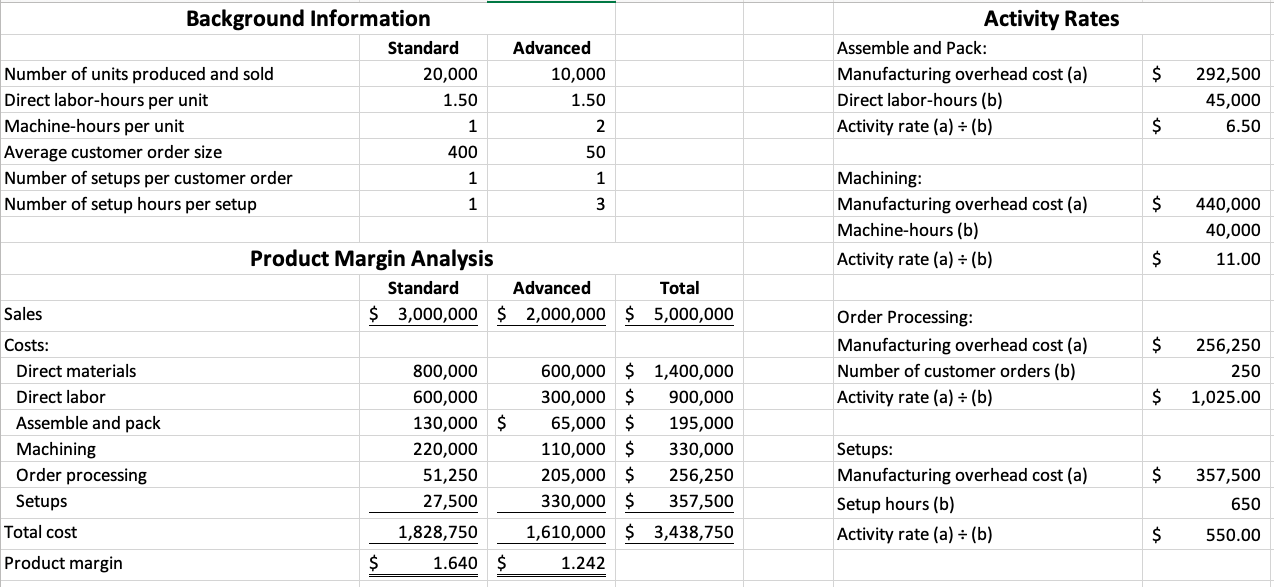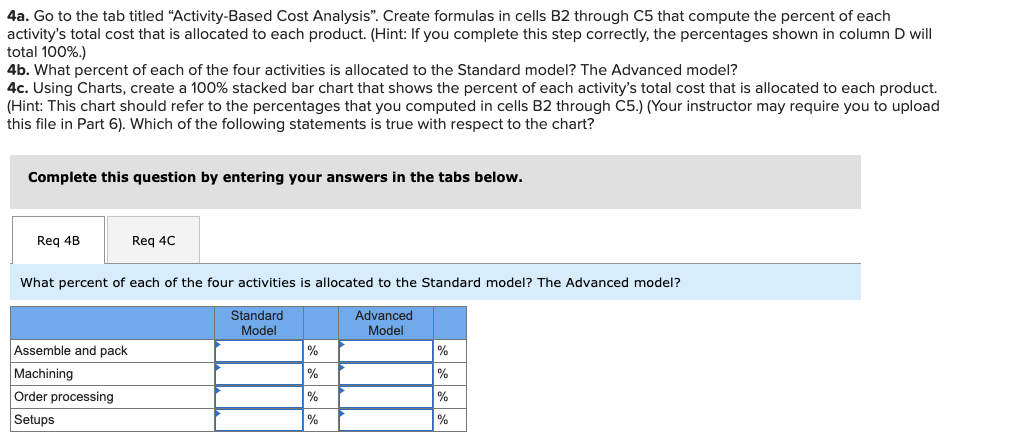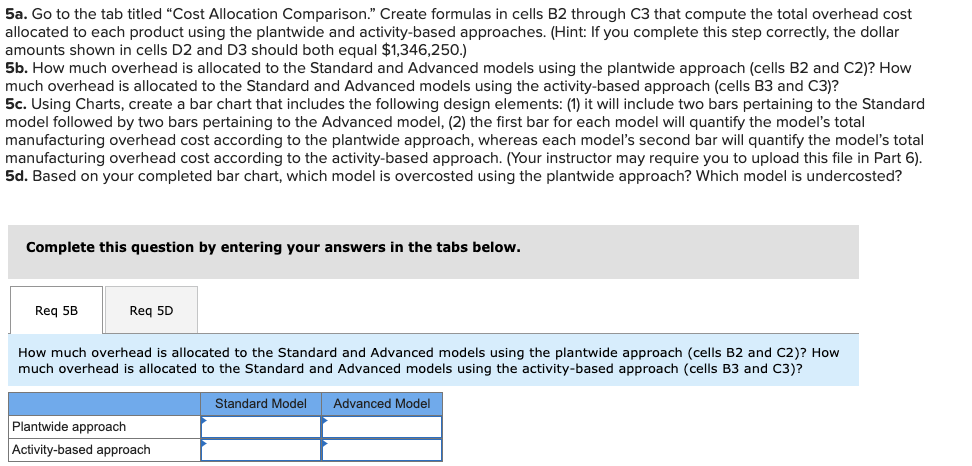



You don't need to do 4c, 5c, or 5d. This is all the information I have, excel screenshot is included, can't attach an excel file. Please explain any answers, Thanks!


Cary Company manufactures two models of industrial components-a Standard model and an Advanced Model. It has provided the following information with respect to these two products: Number of units produced and sold Selling price per unit Direct materials per unit Direct labor cost per unit Direct labor-hours per unit Standard 20,000 $ 150 $ 40 $ 30 1.50 Advanced 10,000 $ 200 $ 60 $ 30 1.50 The company considers all of its manufacturing overhead costs ($1,346,250) to be fixed and it uses plantwide manufacturing overhead cost allocation based on direct labor-hours. Advanced 10,000 1.50 Background Information Standard Number of units produced and sold 20,000 Direct labor-hours per unit 1.50 Machine-hours per unit 1 Average customer order size 400 Number of setups per customer order 1 Number of setup hours per setup 1 Activity Rates Assemble and Pack: Manufacturing overhead cost (a) Direct labor-hours (b) Activity rate (a) = (b) $ 292,500 45,000 6.50 2 $ 50 1 3 $ Machining: Manufacturing overhead cost (a) Machine-hours (b) Activity rate (a) = (b) 440,000 40,000 11.00 $ Product Margin Analysis Standard Advanced Total $ 3,000,000 $ 2,000,000 $5,000,000 Sales $ Order Processing: Manufacturing overhead cost (a) Number of customer orders (b) Activity rate (a) (b) 256,250 250 1,025.00 $ Costs: Direct materials Direct labor Assemble and pack Machining Order processing Setups Total cost Product margin 800,000 600,000 130,000 $ 220,000 51,250 27,500 1,828,750 1.640 $ 600,000 $1,400,000 300,000 $ 900,000 65,000 $ 195,000 110,000 $ 330,000 205,000 $ 256,250 330,000 $ 357,500 1,610,000 $ 3,438,750 1.242 $ Setups: Manufacturing overhead cost (a) Setup hours (b) Activity rate (a) = (b) 357,500 650 $ 550.00 $ 4a. Go to the tab titled "Activity-Based Cost Analysis". Create formulas in cells B2 through C5 that compute the percent of each activity's total cost that is allocated to each product. (Hint: If you complete this step correctly, the percentages shown in column D will total 100%.) 4b. What percent of each of the four activities is allocated to the Standard model? The Advanced model? 4c. Using Charts, create a 100% stacked bar chart that shows the percent of each activity's total cost that is allocated to each product. (Hint: This chart should refer to the percentages that you computed in cells B2 through C5.) (Your instructor may require you to upload this file in Part 6). Which of the following statements is true with respect to the chart? Complete this question by entering your answers in the tabs below. Req 4B Req 4C What percent of each of the four activities is allocated to the Standard model? The Advanced model? Standard Model Advanced Model % % % % Assemble and pack Machining Order processing Setups % % % % 5a. Go to the tab titled "Cost Allocation Comparison." Create formulas in cells B2 through C3 that compute the total overhead cost allocated to each product using the plantwide and activity-based approaches. (Hint: If you complete this step correctly, the dollar amounts shown in cells D2 and D3 should both equal $1,346,250.) 5b. How much overhead is allocated to the Standard and Advanced models using the plantwide approach (cells B2 and C2)? How much overhead is allocated to the Standard and Advanced models using the activity-based approach (cells B3 and C3)? 5c. Using Charts, create a bar chart that includes the following design elements: (1) it will include two bars pertaining to the Standard model followed by two bars pertaining to the Advanced model, (2) the first bar for each model will quantify the model's total manufacturing overhead cost according to the plantwide approach, whereas each model's second bar will quantify the model's total manufacturing overhead cost according to the activity-based approach. (Your instructor may require you to upload this file in Part 6). 5d. Based on your completed bar chart, which model is overcosted using the plantwide approach? Which model is undercosted? Complete this question by entering your answers in the tabs below. Req 5B Req 5D How much overhead is allocated to the Standard and Advanced models using the plantwide approach (cells B2 and C2)? How much overhead is allocated to the Standard and Advanced models using the activity-based approach (cells B3 and C3)? Standard Model Advanced Model Plantwide approach Activity-based approach Standard Advanced Activity Assemble and pack Machining Order processing Setups Total 0% 0% 0% 0% Standard Advanced Total Plantwide approach: Total overhead cost allocated Activity-based approach: Total overhead cost allocated $ $ Cary Company manufactures two models of industrial components-a Standard model and an Advanced Model. It has provided the following information with respect to these two products: Number of units produced and sold Selling price per unit Direct materials per unit Direct labor cost per unit Direct labor-hours per unit Standard 20,000 $ 150 $ 40 $ 30 1.50 Advanced 10,000 $ 200 $ 60 $ 30 1.50 The company considers all of its manufacturing overhead costs ($1,346,250) to be fixed and it uses plantwide manufacturing overhead cost allocation based on direct labor-hours. Advanced 10,000 1.50 Background Information Standard Number of units produced and sold 20,000 Direct labor-hours per unit 1.50 Machine-hours per unit 1 Average customer order size 400 Number of setups per customer order 1 Number of setup hours per setup 1 Activity Rates Assemble and Pack: Manufacturing overhead cost (a) Direct labor-hours (b) Activity rate (a) = (b) $ 292,500 45,000 6.50 2 $ 50 1 3 $ Machining: Manufacturing overhead cost (a) Machine-hours (b) Activity rate (a) = (b) 440,000 40,000 11.00 $ Product Margin Analysis Standard Advanced Total $ 3,000,000 $ 2,000,000 $5,000,000 Sales $ Order Processing: Manufacturing overhead cost (a) Number of customer orders (b) Activity rate (a) (b) 256,250 250 1,025.00 $ Costs: Direct materials Direct labor Assemble and pack Machining Order processing Setups Total cost Product margin 800,000 600,000 130,000 $ 220,000 51,250 27,500 1,828,750 1.640 $ 600,000 $1,400,000 300,000 $ 900,000 65,000 $ 195,000 110,000 $ 330,000 205,000 $ 256,250 330,000 $ 357,500 1,610,000 $ 3,438,750 1.242 $ Setups: Manufacturing overhead cost (a) Setup hours (b) Activity rate (a) = (b) 357,500 650 $ 550.00 $ 4a. Go to the tab titled "Activity-Based Cost Analysis". Create formulas in cells B2 through C5 that compute the percent of each activity's total cost that is allocated to each product. (Hint: If you complete this step correctly, the percentages shown in column D will total 100%.) 4b. What percent of each of the four activities is allocated to the Standard model? The Advanced model? 4c. Using Charts, create a 100% stacked bar chart that shows the percent of each activity's total cost that is allocated to each product. (Hint: This chart should refer to the percentages that you computed in cells B2 through C5.) (Your instructor may require you to upload this file in Part 6). Which of the following statements is true with respect to the chart? Complete this question by entering your answers in the tabs below. Req 4B Req 4C What percent of each of the four activities is allocated to the Standard model? The Advanced model? Standard Model Advanced Model % % % % Assemble and pack Machining Order processing Setups % % % % 5a. Go to the tab titled "Cost Allocation Comparison." Create formulas in cells B2 through C3 that compute the total overhead cost allocated to each product using the plantwide and activity-based approaches. (Hint: If you complete this step correctly, the dollar amounts shown in cells D2 and D3 should both equal $1,346,250.) 5b. How much overhead is allocated to the Standard and Advanced models using the plantwide approach (cells B2 and C2)? How much overhead is allocated to the Standard and Advanced models using the activity-based approach (cells B3 and C3)? 5c. Using Charts, create a bar chart that includes the following design elements: (1) it will include two bars pertaining to the Standard model followed by two bars pertaining to the Advanced model, (2) the first bar for each model will quantify the model's total manufacturing overhead cost according to the plantwide approach, whereas each model's second bar will quantify the model's total manufacturing overhead cost according to the activity-based approach. (Your instructor may require you to upload this file in Part 6). 5d. Based on your completed bar chart, which model is overcosted using the plantwide approach? Which model is undercosted? Complete this question by entering your answers in the tabs below. Req 5B Req 5D How much overhead is allocated to the Standard and Advanced models using the plantwide approach (cells B2 and C2)? How much overhead is allocated to the Standard and Advanced models using the activity-based approach (cells B3 and C3)? Standard Model Advanced Model Plantwide approach Activity-based approach Standard Advanced Activity Assemble and pack Machining Order processing Setups Total 0% 0% 0% 0% Standard Advanced Total Plantwide approach: Total overhead cost allocated Activity-based approach: Total overhead cost allocated $ $












